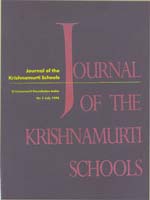Issue 2 - July 1998

- Written by J. Krishnamurti
To understand anything, any human or scientific problem, what is important, what is essential?
- Written by Ahalya Chari
We all know that visitors to our schools, professional or otherwise, go back with a feeling that here is an educational environment that is friendly, warm, inviting; that this is basically a happy community of teachers and students who go about their activities joyously and yet seriously.
- Written by Stephen Smith
It is strange, indeed, that even in the context, of the Krishnamurti schools, we hesitate to talk about (much less probe into), the very central question of consciousness.
- Written by G. Gautama
At the outset these two words would to appear to have little in common.
- Written by O. R. Rao
'We teach what we know, but educate what we are'
- Written by David Moody
What is the relationship, if any, between the teachings of Krishnamurti, and the findings of contemporary research in educational psychology?
- Written by P. Krishna
Krishnamurti has emphasised the need for students and teachers to learn about themselves while they are teaching and learning about the world around them, through the planned curriculum and activities of the school.
- Written by Shailesh Shirali
Culture classes have become an integral part of the curriculum at most K schools, yet their scope and purpose remain obscure.
- Written by Vijaylakshmi Jaithirtha
I vividly remember the first school trip in 1983 with a group of standard 9 students at The Valley School.
- Written by Jayant Tengshe
As I reflect upon my plunge into teaching in a school more than a decade ago, I really marvel at how fast time has flown.
- Written by Meredy Maynard
Welcome to the 1997 Oak Grove School Graduation Ceremonies.
- Written by Hema Rao
For seven very inspiring enriching years, I have had the opportunity of living and teaching at Rajghat, on the banks of the Ganga.
- Written by Jordi Brito
In the autumn of 1995 three families at BrockwoodPark School were discussing the possibility of providing some kindof alternative education for their children and started searching for a place where this could happen.
- Written by Kamala Anil Kumar
All too often in our staff meetings, we have deliberated upon our concerns - how to help our children understand that there is more to playing a game than winning or losing, with the accompanying euphoria or disappointment.
- Written by Sukant Mishra
Two distinct, but equally crucial challenges coalesced to inspire the creation of the Valley school Art Village.
- Written by Yasmin Jayathirtha
How would a teacher respond when asked, 'What do you teach when you teach science?'
- Written by D. Anantha Jyothi
In a modern Biology class a teacher no longer draws and labels a hypothetical flower on the blackboard expecting the children to learn it by heart.
- Written by Braj Bhushan
We all agree that as educators our responsibility is not only to impart knowledge, but also to be concerned with the overall development of the child.
- Written by Prema Veeraraghavan
Teaching and learning of classification in Life Science can be very wearisome and dull if taught in the conventional way, using Greek and Latin terms that are found easily in the textbooks.
- Written by Geetha Iyer
Environmental studies have become increasingly integral to modern day curricula.
- Written by Suprabha Seshan
At the edge of the rainforest inWynad, Kerala, some children are sleeping on the floor of a large room.
- Written by Rajan Chandy
Suppose you are sitting around at home one day feeling somewhat bored.
- Written by Alok Mathur and Kanthi Pathak
Living in a world filled with the by-products of human technological advances, one senses the tidal wave of globalization that sweeps across the planet, carrying with it hi-tech products, new lifestyles and a consumer culture to far corners of the globe.
- Written by Kamala Mukunda
Have you recently talked with a three year old, and come away slightly dazed at the degree of sophistication in her conversation - the concepts she understands and applies so appropriately to each situation?
- Written by P. Ramesh
Stephen Jay Gould is one of the most popular writers on science today.
- Written by P. Ramesh
A New Journal Prism: A Learning journal is a publication of Prism Communication, a Paris-based language training association, edited by Richard Laubly and Helen Schall, 151, Rue du Fauborg- Poissonniere, 75009 Paris.

